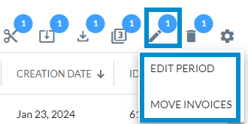What can I do with the action bar in the upper right corner of the invoice overview screen?
By selecting invoices, various functions are available to you in the invoice overview screen through the action bar.
Content
- The invoice overview screen
- Sorting invoices
- Exporting invoices
- Downloading invoices
- Count invoice number up
- Editing & moving invoices
- Deleting invoices
- Customising the invoice overview screen
The invoice overview screen
Once you have selected the Invoices screen in the main menu and selected one or more invoices, the action bar appears in the top right-hand corner. You can find more information on the invoices screen in How do I use the invoices overview screen?.

Sorting invoices
Selecting the scissor symbol takes you to the document sorting screen in which you can, for example, change the process, rotate the document or adjust the page sorting. To be able to edit several invoices simultaneously, the same process must be selected and the invoices must be assigned to the same client.

More information on the restructure screen can be found in How can the automatic sorting of invoice pages be checked and edited?
Exporting invoices
Clicking the export icon allows invoices to be exported to the user’s ERP system or downloaded as a ZIP or UBL file, as well as to be marked "exported".
This is necessary, for example, if invoices have already been collected but do not appear as exported in Finmatics, or if you have downloaded invoices manually to import them into your ERP system.

Downloading invoices
Clicking the download icon allows invoices to be downloaded as images and saved to a computer as .xlsx or e-invoices. For more information read:

Count invoice number up
When using the ERP system BMD, the function "count invoice number up" is available to you.


Editing & moving invoices
If you click on the pencil icon, you can adjust the period and assign the invoices to a different process or client. Here you have the option of selecting several invoices at once and thus adjusting the period at the same time or assigning it to another process.

Deleting invoices
Clicking the trash icon allows selected invoices to be moved to the trash.

Customising the invoice overview screen
If you click on the wheel icon, you can hide or show the columns of the entire screen. For more information, see How can I filter or adapt the screens?.
